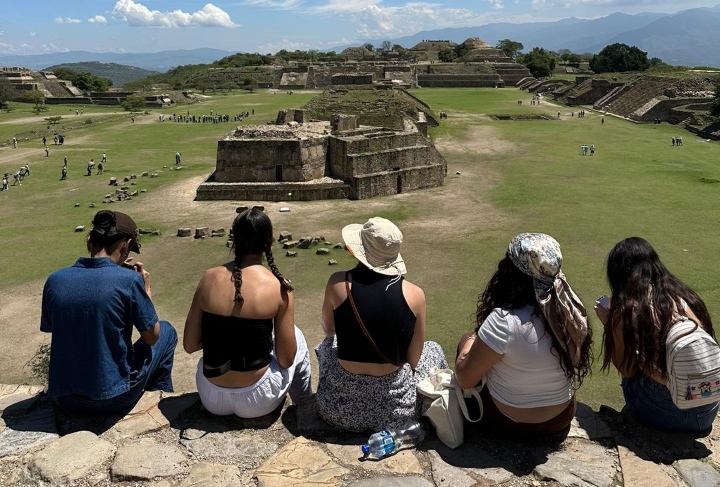SDSU’s Global Health Internship in Oaxaca Provides Clinical Skills, Cultural Insights, and Empathy
Kaylee Chirgwin shadowed health care providers in Oaxaca, Mexico, last summer as part of San Diego State University’s Global Health Internship program. The experience opened her eyes to how language barriers can lead to health disparities.
A nursing major, Chirgwin struggled to grasp “medical Spanish” as she worked alongside doctors and nurses at local hospitals, rural clinics, an orphanage, a labor/delivery center, and a rehabilitation facility. Though she had two years of Spanish in high school, she felt lost sometimes in a clinical environment.
“I thought of people who come to hospitals in the U.S. and don’t speak English, how scary and confusing that could be,” she said. “Gaining that perspective, I think, will help me in my patient care in the future to be more understanding because I had been there once myself.”
Chirgwin navigated the language thicket with the help of colleagues and her Spanish class in Oaxaca. She called the six-week internship one of the most worthwhile educational experiences she’s had, expanding her viewpoint on how health care is delivered outside the U.S.
“There isn’t a better study abroad that you can pick for any health-related major because that clinical experience is so valuable,” said Chirgwin. “Every day you would go to a clinic and see so many different ones. To experience that is something you can’t get anywhere else.”
The internship program, in partnership with the nonprofit Child Family Health International, is readying to send its third group of students to Oaxaca this summer. Applications are open through March 15. Scholarships are available to help defray the $6,400 cost, which includes travel, tuition, meals, and housing with host families.
The program is among SDSU’s efforts to deepen its roots in Oaxaca and deliver more cross-border education opportunities for students. The university opened a Mesoamerican Studies Center in Oaxaca in May 2022 and has eight study abroad programs centered there. The region is a colorful cultural and culinary hub, steeped in history and archeological sites, and is home to more than a dozen officially recognized Indigenous peoples.
The health internship program targets mostly public health, nursing, and social work majors, as well as students on pre-med or pre-dentistry education tracks.
“In a health care landscape where the decline of empathy is well-documented and deeply concerning, SDSU’s Global Health Internship in Oaxaca serves as an immersive experience to empower future health care professionals not only with clinical and technical skills but also with the cultural awareness that fosters critical empathy,” said Maria Keckler, a health care researcher at SDSU’s Virtual Immersive Teaching and Learning Research Center.
The program can be hands-on for students, said Roberto Hernandez, an associate professor of Chicano/Chicana studies who led interns to Oaxaca last summer.
“Oftentimes many of them were commenting that if they were students in the U.S. they might not have experienced some of what they were able to experience in Oaxaca until their second or third year of medical school,” said Hernandez.
While students typically spend four hours per day at clinics, they also take classes afterward on the history and culture of the region.
“It is meant to give a broader and deeper understanding not only of Oaxaca but of Mexico in terms of historical context, political and cultural context so that students can recognize why and how it is that things are done differently there,” said Hernandez. “We do end the course with a little bit of an eye toward Mexican migration to the U.S., specifically related to health outcomes.”
The classroom sessions also delve into cultural humility.
“One of the things we emphasize in the program is the need to put aside our own biases that the health system in the U.S. is best, and we are going to tell them how to do things,” said Hernandez. “We take the position that everyone students are engaging with are the local experts, and we are there to learn from them.”
Students get exposure to Indigenous medicine through classroom presentations from native healers, as many Indigenous cultures are woven into the fabric of the Oaxaca region and health care system.

Students visit an archeological site near Oaxaca City.
Benjamin Mosco, a public health major, saw the Global Health Internship as a path to discover more about his Mexican heritage while getting clinical experience.
He had a few unforgettable experiences in the field. He became emotional during the rotation at Casa Hogar, a facility that cares for orphaned and poor youths, many of them Indigenous and some with special needs. The boys called him “father.” In one case, a child was going home to biological parents, and the Casa Hogar staff cried as they said goodbye.
“This showed me how much they care about these kids,” he said. “They are such great people, and the world needs more of them.”

